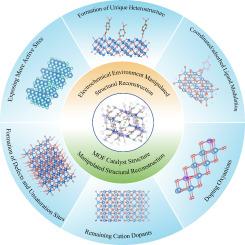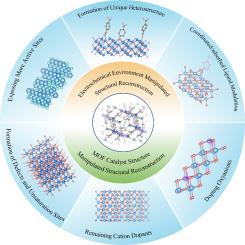Triggered factors and structure-activity relationship in the dynamic reconstruction processing of MOF for the alkaline oxygen evolution reaction
IF 20.3
1区 化学
Q1 CHEMISTRY, INORGANIC & NUCLEAR
引用次数: 0
Abstract
Metal-organic frameworks (MOF) are promising electrocatalysts for the oxygen evolution reaction (OER). MOFs precatalysts undergo a structural reconstruction that results in the formation of transition metal hydroxyoxides (MOOH) during the OER process, which are widely regarded as the authentic catalytic species for OER. This review comprehensively summarizes the recent progress in the research field of MOF-based OER electrocatalysts in terms of structural reconstruction and analyzes in depth the intrinsic relationship between dynamic reconstruction mechanisms and structural activity. By studying two primary triggering factors for reconstruction: the manipulation of the electrochemical environment and the MOF structure, we aim to understand in detail the dynamic pathway of MOF reconstruction and its correlation with the OER catalytic activity in real time. In addition, this review also addresses the self-healing capabilities of reconstructed MOFs and the stability of their framework structures, providing important insights into the long-term performance of these catalysts. Finally, we propose a new direction for future research based on the current state of knowledge, aimed to better understanding how the microchemical environment affects catalytic activity during dynamic reconstruction, in order to facilitate the design and development of highly efficient MOF-based OER catalysts in the future and make it easier to navigate the future.


用于碱性氧进化反应的 MOF 动态重构加工中的触发因素和结构-活性关系
金属有机框架(MOF)是氧气进化反应(OER)中很有前景的电催化剂。MOFs 前催化剂在 OER 过程中会发生结构重构,形成过渡金属羟氧化物 (MOOH),被广泛认为是 OER 的真正催化剂。本综述全面总结了基于 MOF 的 OER 电催化剂在结构重构方面的最新研究进展,并深入分析了动态重构机制与结构活性之间的内在联系。通过研究重构的两个主要触发因素:电化学环境和 MOF 结构的操作,我们旨在详细了解 MOF 重构的动态途径及其与 OER 催化活性的实时相关性。此外,本综述还探讨了重构 MOF 的自愈能力及其框架结构的稳定性,为了解这些催化剂的长期性能提供了重要依据。最后,我们在现有知识水平的基础上提出了未来研究的新方向,旨在更好地理解微化学环境如何在动态重构过程中影响催化活性,以促进未来基于 MOF 的高效 OER 催化剂的设计和开发,使其更容易驾驭未来。
本文章由计算机程序翻译,如有差异,请以英文原文为准。
求助全文
约1分钟内获得全文
求助全文
来源期刊

Coordination Chemistry Reviews
化学-无机化学与核化学
CiteScore
34.30
自引率
5.30%
发文量
457
审稿时长
54 days
期刊介绍:
Coordination Chemistry Reviews offers rapid publication of review articles on current and significant topics in coordination chemistry, encompassing organometallic, supramolecular, theoretical, and bioinorganic chemistry. It also covers catalysis, materials chemistry, and metal-organic frameworks from a coordination chemistry perspective. Reviews summarize recent developments or discuss specific techniques, welcoming contributions from both established and emerging researchers.
The journal releases special issues on timely subjects, including those featuring contributions from specific regions or conferences. Occasional full-length book articles are also featured. Additionally, special volumes cover annual reviews of main group chemistry, transition metal group chemistry, and organometallic chemistry. These comprehensive reviews are vital resources for those engaged in coordination chemistry, further establishing Coordination Chemistry Reviews as a hub for insightful surveys in inorganic and physical inorganic chemistry.
 求助内容:
求助内容: 应助结果提醒方式:
应助结果提醒方式:


